#Johann Gottfried Herder
Text
In novels we cry for the butterfly whose wings get wetted by the rain; in
conversations we bubble over with great sentimental dispositions – and
for this moral corruption of our species, from which all evil arises, we
have no eye. We slaughter to greed, to pride, to our slothful boredom a
thousand sacrificial victims who do not cost us a single tear. One hears of
thirty thousand human beings left dead on the battlefield for nothing as
one hears of cockchafers that have been shaken down, of a field of crops
ruined by hail, and one will perhaps feel sorrier about the latter disaster
than about them.
Johann Gottfried Herder, 'Letters for the Advancement of Humanity' (1793-1797)
8 notes
·
View notes
Text
Weißt du, was nie zu sättigen ist? Das Auge der Habsucht. Alle Güter der Welt füllen die Höhle nicht aus.
You know what's never to be satisfied? The eye of greed. All the goods in the world do not fill the cave.
Johann Gottfried Herder (1744 – 1803), German poet, translator, theologist, and philosopher
59 notes
·
View notes
Text
I am not here to think, but to be, feel, live!...Heart! Warmth! Blood! Humanity! Life!
-Johann Gottfried Herder
3 notes
·
View notes
Text

Die größten Veränderungen der Welt sind von Halbwahnsinnigen bewirkt worden. /Herder
1 note
·
View note
Text
It has been all too easy for historians to look back at the course of German history from the vantage-point of 1933 and interpret almost anything that happened in it as contributing to the rise and triumph of Nazism. This had led to all kinds of distortions, with some historians picking choice quotations from German thinkers such as Herder, the late eighteenth-century apostle of nationalism, or Martin Luther, the sixteenth-century founder of Protestantism, to illustrate what they argue are ingrained German traits of contempt for other nationalities and blind obedience to authority within their own borders. Yet when we look more closely at the work of thinkers such as these, we discover that Herder preached tolerance and sympathy for other nationalities, while Luther famously insisted on the right of the individual conscience to rebel against spiritual and intellectual authority. Moreover, while ideas do have a power of their own, that power is always conditioned, however indirectly, by social and political circumstances, a fact that historians who generalized about the 'German character' or 'the German mind' all too often forgot.
— The Coming of the Third Reich (Richard J. Evans)
#book quotes#richard j. evans#the coming of the third reich#history#military history#politics#political philosophy#academia#philosophy#sociology#totalitarianism#fascism#nazism#germany#weimar republic#nazi germany#ww2#holocaust#johann gottfried herder#martin luther
0 notes
Text
An die Bäume im Winter
Gute Bäume, die ihr die starr entblätterten Arme
Reckt zum Himmel und fleht wieder den Frühling herab!
Ach, ihr müßt noch harren, ihr armen Söhne der Erde,
Manche stürmige Nacht, manchen erstarrenden Tag!
Aber dann kommt wieder die Sonne mit grünenden Frühling Euch; nur kehret auch mir Frühling und Sonne zurück?
Harre geduldig, Herz, und birg in die Wurzel den Saft dir;
Unvermutet vielleicht treibt ihn das Schicksal empor.
--Johann Gottfried von Herder
18 notes
·
View notes
Text
Michael N. Forster – Herder’in Felsefesi (2023)
Johann Gottfried von Herder (1744-1803), Aydınlanma çağının büyük filozoflarından olduğu gibi, dilbilim ile antropoloji, zihin felsefesi gibi alanların doğuşunda da önemli role sahiptir.
Amerikalı ünlü felsefe tarihçisi Michael N. Forster bu çalışmada modern Batı düşüncesinin en önemli isimlerinden Herder’i (1744-1803) ve onun olağanüstü entelektüel mirasını inceliyor.
Aydınlanma Çağının bu büyük…

View On WordPress
#2023#Beyoğlu Kitabevi#Hasan Aksakal#Herder’in Felsefesi#Johann Gottfried von Herder#Michael N. Forster
0 notes
Text
CANTO 6 PART 3 SPOILERS
Im beyond pissed, tumblr crashed in the middle of me doing this so this is going to be so much shorter than I want it to be. NON RYOSHU RELATED POST ABOUT THE HEATHCLIFF. DON'T TAKE WHAT I SAY AS FACT I AM NOT QUALIFIED FOR THIS. LOOK AT THE LINKS I CITE FOR MORE INFORMATION! You can click them when their mentioned. Im not citing in the proper format. This was done on 5 hours of sleep, two eggs, and a box of banana milk.
youtube
The Erlkonig or Erlking is this figure in German Mythology who kidnapps children. When he touches you, he kills you. This poem made by Johann Wolfgang von Goethe then adapted to this song is what you see. Erlkoning Heathcliff is trying to intice Heathcliff to die by telling him that it's his fault Cathy is dead. All identities refer to the sinner as "child" when you look into their uptie stories. Mili and the singer of the video here use the same technique of changing the tone and pitch of their voice to differntiate two characters.
The Wild Hunt is a part of Norse Mythology where Odin, mounted on his sixed legged horse Sleipnir, goes through the forest. According to norse-mythology.org, anyone who gets caught up in The Wild Hunt, spotted or seen, gets carried away. Your soul will get incorporated into The Wild Hunt. We all know Erlking Heathcliff did, the rising of the bodies. The Wild Hunt is also mostly describe as having hounds, and who was a hound? Hindleys.
From the same website, on the page of Sleipnir reads,

Also, the horse that heath rides on has a weird liney pattern on it's 4 legs that kind of look like that runestone. There's more connection here, I just don't want to type it again.
How did Project Moon mix two diffrent mythological ideas together? (Its not just two, they mixed so many more.) Meet human mistranslation and the progression of oral tradition and story telling throught time. I don't kno where to start. There was mistranslation poem when, according to ancient-origins.net Johann Gottfried Herder wrote a seperate ballad from the one I linked at the start called Erlkönigs Tochter.
The Anglo-Saxons were early German settlers. This is where things get messy because I have several more potential leaders of the Wild Hunt but here are two, King Herla and Herne The Hunter.
Herne The Hunter: Popularized by Shakespeare potentially from a play called The Merry Wives of Windsor. This man called Jacobb Grimm said that Hene The Hunter was related to Odin. Herne the hunter is this ghost. ( https://mythopedia.com/topics/herne-the-hunter ) Im trying to say there are other media that connect the Erlking to the Wild Hunt but its on Wikipedia so it makes it seem fishy. Another Link Here


King Herla: A british king who attended a dwarf wedding. When he left the wedding, the world had changed. Unbeknowst to him, 300 years had passed and he was claimed to be missing. When his men tried to get off their horses, they turned into dust so they were stuck like that. Read it here, its short. Someone better and more credible than me summed the story up better than I did, historian Chrissy Senecal. Read right here. An additional link to cross refrence if you'd like. King Herla and Odin got conflated together when really, their diffrent people
I found this other website article about Wild Hunts which kind of brings me to the next thing, the Harlequinn. They weild clubs, their devils, the image of them is popularly joyful? Maybe goofy and lighthearted? Perhaps associated with cards? Matt, or Heathcliff's portrayal of Matt. Now, I'm looking at Wikipedia and I see this section.
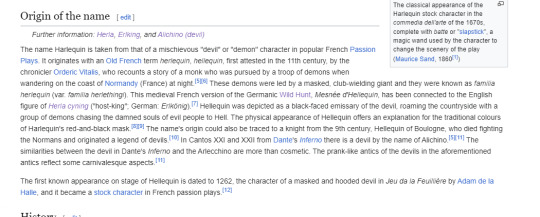
What do we have here? A mention of the Erlkönig, Dante's Inferno, masked, club weilding giant. Heathcliff's not giant but hes pretty tall, at least by my standards but whatever, im very short. DANTE'S INFERNO, Canto 11 and 12. What the fuck Project Moon, are you playing 5d chess?
Back on topic, Hellequin is the fairy king, and this figure pops up in German, French, Italian, and English folklore. I can't do proper research when all my search results are mixed with random junk and I'm becoming nutty. You will not normally be able to access this article without paying but here's the link anyways. Journal Article from this book on a section about horned deities made in 1922 speaks of a group of ghost riding, who are also huntsman.
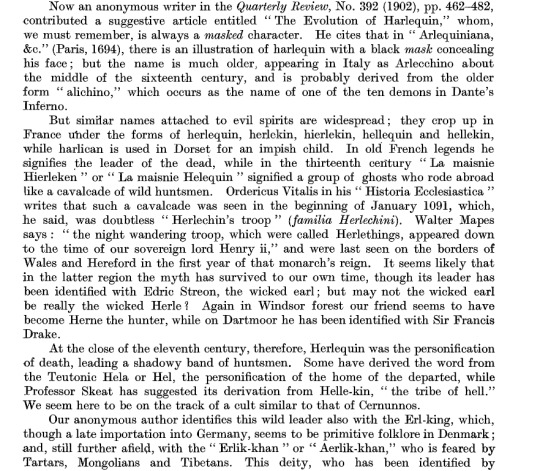
And also another mention of Dante's Inferno. The name, Herne The Hunter is mentioned again.
All and all, The link between The Erlkonig and The Wild Hunt isn't as wild and unexplainable as I originally thought. It's just so cool to see all these concepts intersect. There still so much to touch upon like the headless horseman refrence and the Dullahans, RYOSHU COMPARING THE WILD HUNT TO THE PARADE OF 100 SPIRTS, something along that line, I forgot the name. I'm just not the right person to yell about this but I will anyways. The writers mixed so many symbols of death into one character. Such a wild and nutty Canto. Thank you so much Project Moon.
#not ryoshu#not ryoshu related#limbus company#lcb heathcliff#a link between The Erlking and The Wild Hunt#canto 6 spoilers
49 notes
·
View notes
Text

The Ifenkönig
Characters: Finwë, Míriel, Námo, mentions of Vairë and Nienna
Synopsis: When Míriel falls ill after childbirth, Finwë tries to take her to the gardens of Lórien for healing; however, the Lord of the Dead already has his sights set on her.
Warnings: Sickness, death, dark!Námo
Poetry
Also available on AO3

Disclaimer: This isn't an original poem written by me, this is based on and adapted from "Erlkönig" by Johann Wolfgang von Goethe and Edgar Alfred Bowring's English translation of the poem (both of which you can read here). It's a sort of "remix" if you will, just as a fun little exercise because I had this random idea of a darker verse in which Námo actively takes Míriel's soul and this poem fits the vibe.
Title translation and explanation will be down below.

Who rides so late through the night dark and drear?
King Finwë it is, with his lady wife dear.
He holds her tightly embraced in his arm,
He holds her tenderly and keeps her warm.
“My dear lady, wherefore d’you avert your eye?”
“Do you not see, my lord, the Doomsman close by?
Do you not see him, with death veil and dark train?”
“Dearest, it must be mist rising over the plain.”
“Oh come to me, lovely Míriel, ere midnight falls
For there’s peace, quiet and healing in my halls;
From a safe distance, we shall watch fate unfold
And my lady shall adorn you with robes of gold.”
“Oh husband, husband, but do you not hear
The words the Judge whispers in my ear?”
“Be calm, dear wife, your fancy deceives
It is only the wind whispering through leaves.”
“Won’t you, dear Míriel, accompany me there?
I shall leave you in my sister’s loving care;
I shall give you to my wife to keep
She shall sing and hold you in your sleep.”
“Oh husband, husband, but do you not see
The Doomsman brought wife and sister for me?”
“My love, my love, it is quite alright
The mist again is deceiving your sight.”
“My wife, as am I, is charmed by your beauty,
Come with me now, to fulfil my duty.”
“Oh husband, husband, I fear he takes me at last
His hands hold my soul, he’s seizing me fast.”
King Finwë now hurries, afraid for her life
He holds in his arms his shivering wife
He reaches the gardens with terror and dread
His queen he finds silent, unmoving and dead.

Ifen (also If, Ibe, Eve, Eue) -> Eibe -> Yew
König -> King
The yew tree is commonly associated with death.
The original title, Erlkönig, translated as Erl-King (the literal meaning being alder (tree) king), comes from the Danish word elle which, according to several sources, can mean either alder or elf, so it's possible that Johann Gottfried Herder - who translated the material that Goethe later adapted originally - made an error; it's also possible he intentionally chose this meaning.
Ergo, the Erl-King could also be an Elf-King, which I thought was a neat tidbit to mention for my fellow Tolkien fans ^^

Thanks for reading!♡
Read more? main masterlist
Get tagged for my writing? tag list form
taglist: @a-contemplation-upon-flowers @asianbutnotjapanes @a-world-of-whimsy-5 @bluezenzennie @edensrose @eunoiaastralwings @i-did-not-mean-to @melkors-defense-attorney @singleteapot @wandererindreams
#finwe#finwë#miriel#míriel#finwe x miriel#namo#mandos#dark!namo#dark!valar#poetry#remix poem#silmarillion#tolkien
20 notes
·
View notes
Text
THIS DAY IN GAY HISTORY
based on: The White Crane Institute's 'Gay Wisdom', Gay Birthdays, Gay For Today, Famous GLBT, glbt-Gay Encylopedia, Today in Gay History, Wikipedia, and more … January 12

1564 – Queen Elizabeth I reinstates the buggery law in England which makes sodomy illegal.

1706 – Pennsylvania eliminates the castration penalty from its sodomy law.


1751 – On this date the Baltic German writer of the Sturm und Drang movement Jakob Lenz was born (d.1792). Lenz is remembered as the most creative and original of Goethe's Strasbourg friends and, because of failures in his personal life, as a figure of pathos. The son of a Lutheran pastor who received a theological education at the University of Koenigsberg, Lenz was a religious thinker who saw himself as prophet as well as poet.
In 1771 in Strasbourg, he met the young Johann Wolfgang von Goethe, who at this time happened to be in Strasbourg, and whose acquaintance Lenz made, as well as that of Johann Heinrich Jung-Stilling. Goethe now became Lenz's literary idol, and through him he made contact with Johann Gottfried Herder and Johann Kaspar Lavater, with whom he corresponded.
In the following year, 1772, Lenz accompanied his literary masters to the garrisons of Landau, Fort Louis and Wissembourg. He also fell in love with Friederike Brion, once the beloved of Goethe, but his feelings were not reciprocated.
Recent scholarship has has revealed Lenz's relationship with Goethe. In books like Karl Hugo Pruys' "The Tiger's Tender Touch: The Erotic Life of Goethe" and Alice Kuzniar's "Outing Goethe and His Age" Lenz's full character and sexuality has been revived. Lenz was deeply in love with Goethe. Indeed he wrote countless love letters to the writer in which he professed his desire to be Goethe's wife.
Historians of Goethe have always been puzzled by an incident in Goethe's life. In April 1776 Lenz followed Goethe to the court of Weimar where he was at first amicably received. But in early December, on Goethe's instigation, he was expelled. The exact circumstances are not recorded; Goethe, who broke off all personal contact with him after this, refers only vaguely in his diary to "Lenz's idiocy" ("Lenzens Eseley"). Historians seem puzzled by this strange rejection of Lenz. A clearer reading of their relationship or Lenz's desires for Goethe make the situation a bit more clear. The rejection may have been a break in their relationship or a spurning of Lenz's attentions.


1856 – John Singer Sargent American portrait painter, born (d.1925) was the most successful portrait painter of his era, as well as a gifted landscape painter and watercolorist. Sargent was born in Florence, Italy to American parents. He studied in Italy and Germany, and then in Paris under Emile Auguste Carolus-Duran. Among the artists with whom Sargent associated were Dennis Miller Bunker, Carroll Beckwith, Edwin Austin Abbey (who also worked on the Boston Public Library murals), Francis David Millet, Wilfrid de Glehn, Jane Emmet de Glehn and Claude Monet, whom Sargent painted.
He developed a life-long friendship with fellow painter Paul César Helleu, whom he met in Paris in 1878 when Sargent was twenty-two and Helleu was eighteen. Sargent painted both Helleu and his wife Alice on several occasions, most memorably in the impressionistic Paul Helleu Sketching with his Wife, 1889. His supporters included Henry James, Isabella Steward Gardner, (who commissioned and purchased works from Sargent and sought his advice on other acquisitions) and Edward VII, whose recommendation for knighthood the artist declined.
Sargent was, as they say, "extremely private regarding his personal life," though the painter Jacques-Émile Blanche, who was one of his early sitters, said — after his death — that Sargent's sex life "was notorious in Paris, and in Venice, positively scandalous. He was a frenzied bugger." Was the bugger refernce as in "buggery"?. As homophobic scholars put it, "the truth of this may never be established." Some have gone so far as to boldly suggest that Sargent was homosexual. He had personal associations with Prince Edmond de Polignac and Count Robert de Montesquiou (the model for Des Esseintes in Huysman's A Rebours, and even more famously, the Baron de Charlus in Proust's A la recherche du temps perdu, and, in real life, if you will, Prince Polignac's life-long lover, as well), two of the most notorious homosexuals of the age.

Sargent's male nudes reveal complex and well-considered artistic sensibilities about the male physique and sensuality; particularly evident in his portrait of Thomas E. McKeller but also in Tommies Bathing (both above), nude sketches for Hell and Judgement, and his portraits of young men, like Bartholomy Maganosco and Head of Olimpio Fusco .
There were friendships with women, as well, and a similar sensualism informs his female portrait and figure studies (notably Egyptian Girl, 1891). The likelihood of an affair with Louise Burkhardt, the model for Lady with the Rose, and the first wife of author J.R. Ackerley's father is accepted by Sargent scholars. Sargent's friends went so far as to wonder if he and Burckhardt had formed a romantic attachment. His enthusiasm while creating the picture of her probably instigated the rumors, but a mutual friend learns from Sargent in 1882 that "he does not care a straw for her." Despite numerous friendships with women throughout his life, this is the only episode to cause associates to doubt his status as a "committed bachelor." His sensuous, unparalleled appreciation of male beauty leaps off the canvas to this day.


1941 – On this date the pioneering British bluesman Long John Baldry was born (d.2005). Born John William Baldry in England, he grew to 6' 7" which resulted in the nickname "Long" John. Gifted with a deep, rich voice, he was one of the first British vocalists to sing blues in clubs.
In the early 1960s, he sang with the seminal band, Alexis Korner's Blues Incorporated, with whom he recorded the first British blues album in 1962, "R&B at the Marquee." At stages, future Rolling Stones members Mick Jagger, Charlie Watts, Keith Richards and Brian Jones played in the band. The Rolling Stones supported Baldry in their first concert at the Marquee Club. Later, Baldry was the announcer introducing The Stones on their US-only live album, "Got Live if You Want It!," in 1966.
Baldry became friends with Paul McCartney after a show at the Cavern Club in Liverpool in the early 1960s, leading to an invitation to play on one of The Beatles 1964 TV specials. In 1963, Baldry joined the Cyril Davies R&B All Stars with Jimmy Page on guitar and Nicky Hopkins playing piano. He took over in 1964 after the death of Cyril Davies. It became Long John Baldry and his Hoochie Coochie Men featuring Rod Stewart on vocals and Geoff Bradford on guitar. Stewart was recruited after Baldry heard him busking a Muddy Waters song at Twickenham station after Stewart had been to a gig at Eel Pie Island.
In 1965, the Hoochie Coochie Men became Steampacket with Baldry and Stewart as male vocalists, Julie Driscoll as the female vocalist and Brian Auger on Hammond organ. After Steampacket broke up in 1966, Baldry formed Bluesology featuring Reg Dwight on keyboards and Elton Dean, later of Soft Machine, as well as Caleb Quaye on guitar. Dwight adopted the name "Elton John" (taking his first name from another member of the band, Elton Dean, and his surname from Baldry).
In 1967, he recorded a pop song "Let the Heartaches Begin" that went to number one in Britain, followed by a 1968 top 20 hit titled "Mexico", which was the theme of the UK Olympic team that year. "Let the Heartaches Begin" made the lower reaches of the Billboard Hot 100 in the US.
Baldry was openly gay during the early 1960s when homosexuality was still criminalised and medicalised. Baldry supported Elton John in coming to terms with his own sexuality. In 1978 his album Baldry's Out announced his formal coming out, and he addressed sexuality issues on A Thrill's a Thrill, a song on the LP.
Bluesology broke up in 1968, with Baldry continuing his solo career and John forming a songwriting partnership with Bernie Taupin. In 1969, Elton John tried to commit suicide after relationship problems with a woman. Taupin and Baldry, who was by now openly Gay, found him, and Baldry talked him out of marrying the woman, helping make John comfortable with his sexuality. The song "Someone Saved My Life Tonight" from "Captain Fantastic and the Brown Dirt Cowboy" was about the experience.
In 1971, Elton John and Stewart each produced one side of "It Ain't Easy" which became Baldry's most popular album and made the top 100 of the US album charts. The album featured "Don't Try to Lay No Boogie Woogie on the King of Rock and Roll" which became his most successful song in the US. John's first tour of the US was this time. Baldry's 1972 album "Everything Stops For Tea" made the lower reaches of the US album charts.
After time in New York City and Los Angeles in 1978, Baldry settled in Vancouver, British Columbia, where he became Canadian. He toured the west coast, as well as the U.S. Northwest. Baldry also toured the Canadian east, including one 1985 show in Kingston, Ontario, where audience members repeatedly called for the title track from his 1979 album "Baldry's Out!" - to which he replied, "I'll say he is!"
He played his last live show in Columbus, Ohio, on July 19, 2004.


1954 – Today is the birthday of Felipe Rose, better known as "the Indian guy from The Village People." He was born in New York and grew up in Brooklyn. He's part American Indian (Lakota) and part Puerto-Rican (on his mother's side). He actually studied dance with the Ballet de Puerto Rico and was later discovered by the music producer Jacques Morali while working as a bartender and dancing in a New York gay club and recruited for a new disco group he was forming.
While the producers were busy recruiting and preparing the other members of the group, Rose was sent to Paris where he choreographed a native dance number for the Crazy Horse Saloon. When he returned to the U.S., he suggested that the other members of the group wear uniforms representing different "manly" occupations in New York's Greenwich Village.The rest as they say is history. His hits with the Village People hits include Macho Man (1978), YMCA (1978), In The Navy (1979), Go West (1979), Can't Stop the Music (1980)
In 2000, Rose began to work on his solo career. His single "Trails of Tears" was nominated for 3 Native American Music Awards for Best Historical Recording, Song of the Year and Best Producer. In 2002, Rose was the opening act of the 5th Annual Native American Music Awards and won a NAMMY Award for the Best Historical Recording.
In 2005 Rose called up the Smithsonian National Museum of the American Indian in Washington, DC to offer them his framed gold record for the disco group's 1978 megahit "Y.M.C.A." The staff of the new museum had never received such a call but were delighted to accept the items into their collection. The Washington Post's writer Hank Stuever opined that the museum accepted the record "on the precept that sooner or later they might need such an artifact of a bygone era, perhaps to flesh out a future exhibit on the folkloric value of disco, and native cultural responses to it."


1974 – Chinese Gay Rights Pioneer,GLBT activist and attorney Zhou Dan came out to his friends in 1998 and the media in 2003. A champion of GLBT rights in China, Zhou writes articles on Chinese gay and lesbian Web sites. Although many GLBT Chinese use pseudonyms, Zhou uses his real name. After revealing his sexuality to a Shanghai newspaper in 2003, Zhou appeared across China in newspapers and magazines and on television. Earlier that year, he established the Shanghai Hotline for Sexual Minorities.
One generation removed from the persecution of gays under the People's Republic of China, Chinese gays encounter different obstacles than their American counterparts. Many Chinese believe that homosexuality exists only in the western world. The absence of legal protection and the threat of social isolation keep most Chinese GLBT individuals in the closet.
Zhou also fights for rights of people living with or affected by HIV/AIDS in China, by advocating a human-rights-based approach to the epidemic.
In 2004, Zhou attended Yale Law School's China Law Center as a visiting scholar. In 2006, he taught China's first graduate class on homosexuality at Fudan University in Shanghai.


1986 – Kieron Richardson, born in Eccles, Greater Manchester, England, is an English actor and Presenter best known for playing the role of Ste Hay in Hollyoaks.
After appearing briefly in the late night Hollyoaks: In the City, Richardson was offered the role of Ste Hay in the early evening Hollyoaks where he appeared for 19 episodes. The character was written out of the show after stealing a car, which resulted in a spectacular crash and his character getting sent to prison. He returned to Hollyoaks on 25 September 2007, and has been a regular cast member since.
Richardson has also made appearances in Holby City, Heartbeat and the feature film Fragments, as well as the pantomime Cinderella as Prince Charming at The Embassy Theatre, Skegness in 2006.
Richardson took part in 2010 series of ITV's Dancing on Ice and was paired with series newcomer Brianne Delcourt. He reached the final, finishing in third place.
In 2011, Richardson and his Hollyoaks ex co-star Bronagh Waugh started presenting on radio station Gaydio.
On 15 September 2010, Richardson revealed on television programme This Morning that he is gay, and accepted it at the age of 20. He was inspired to come out by X Factor winner Joe McElderry. In July 2014, Richardson received a torrent of homophobic abuse via social networking site Twitter. That month Richardson announced his intention to marry long-term partner Carl Hyland the following year. In April 2015, the couple were married in a star-studded ceremony in the Peak District.
In December 2016, Richardson announced they were expecting twins via surrogacy. They have twins born in 2017, a boy and girl.

2009 – On this date a landmark of sorts occurred on American daytime television when after months of teasing and steamy kisses, the soap opera As The World Turns featured the boyfriends Luke and Noah finally having sex in a breakthrough episode for daytime television.

2012 – A firestorm was set off by the revelation that a Canadian government lawyer had filed a document in a divorce case stating that same-sex marriages entered into by foreign couples who reside in jurisdictions that do not recognize same-sex marriage are not valid in Canada.
The statement was at first widely regarded as an attempt to undermine same-sex marriage by the Conservative government of Prime Minister Stephen Harper. After the legal brief had been denounced roundly both in Canada and abroad, the government announced that it had no intention of reopening the question of same-sex marriage and that it recognized as valid the same-sex marriages of foreign nationals.


13 notes
·
View notes
Text
Der Krieg, wo er nicht erzwungene Selbstverteidigung, sondern ein toller Angriff auf eine ruhige, benachbarte Nation ist, ist ein unmenschliches, ärger als tierisches Beginnen, indem er nicht nur die Nation, die er angreift, sondern auch die Nation, die ihn führet, ebenso unverdient als schrecklich hinopfert.
War, when it is not forced self-defense but a mad attack on a quiet neighboring nation, is an inhumane, worse-than-animal undertaking, sacrificing not only the nation it attacks but also the nation waging it both undeservedly and terribly.
Johann Gottfried Herder (1744 – 1803), German poet, translator, theologist, and philosopher
43 notes
·
View notes
Text
Without inspiration the best powers of the mind remain dormant. There is a fuel in us which needs to be ignited with sparks.
-Johann Gottfried Herder
1 note
·
View note
Text

Die menschliche Seele hat ihre Lebensalter wie der Körper. /Herder
0 notes
Text
Deutschribing Germany
Literature
Middle Ages (5th-15th centuries)
Medieval German literature can be divided into two periods: Old High German literature (8th-11th centuries) and Middle High German literature (12th-14th centuries). The only surviving works from the first period are the Hildebrandslied (Lay of Hildebrand), which is the earliest poetic text in German and tells of the tragic encounter in battle between a father and a son, and Muspilli, which deals with the fate of the soul after death and at the Last Judgment.

Middle High German literature saw a 60-year golden age known as mittelhochdeutsche Blütezeit, in which lyric poetry in the form of Minnesang—the German version of courtly love—blossomed thanks to poets such as Walther von der Vogelweide and Wolfram von Eschenbach. Another important genre during this time was epic poetry, of which the most famous example is the Nibelungenlied (The Song of the Nibelungs), which narrates the story of prince Siegfried and princess Kriemhild, among other characters.
Renaissance (15th-16th centuries)
Early New High German literature includes works such as Der Ring (The Ring) by Heinrich Wittenwiler, a 9,699-line satirical poem where each line is marked with red or green ink depending on the seriousness of the material, and Das Narrenschiff (Ship of Fools) by Sebastian Brant, a satirical allegory that contains the ship of fools trope.
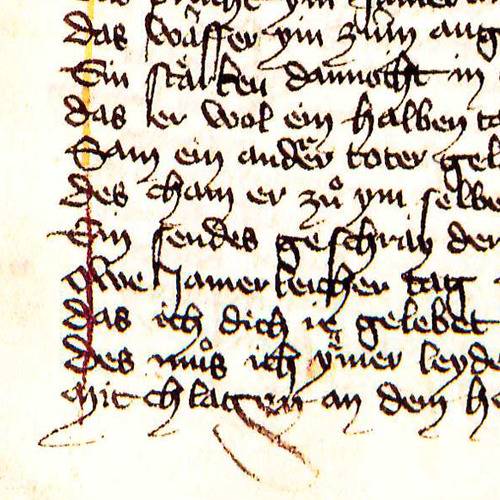
Other important authors are satirist and poet Thomas Murner, humanist Sebastian Franck, and poets Johannes von Tepl and Oswald von Wolkenstein.
Baroque (16th-17th centuries)
The Baroque period is characterized by works that reflected the experiences of the Thirty Years’ War and tragedies (Trauerspiele) on Classical themes, the latter were written by authors such as Andreas Gryphius and Daniel Caspar von Lohenstein. The most famous work is Der abenteuerliche Simplicissimus (Simplicius Simplicissimus) by Hans Jakob Christoffel von Grimmelshausen, a picaresque novel that narrates the adventures of the naïve Simplicissimus.
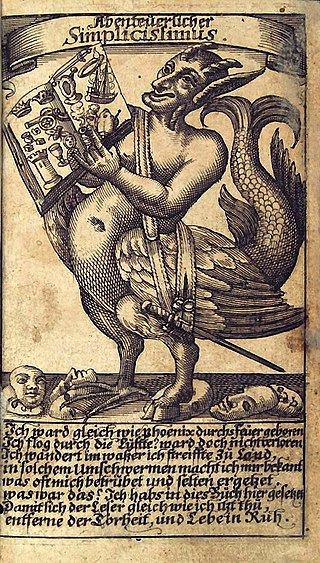
Enlightenment (17th-18th centuries)
The most important writers of the Enlightenment are Christian Felix Weiße, Christoph Martin Wieland, Gotthold Ephraim Lessing, and Johann Gottfried Herder.
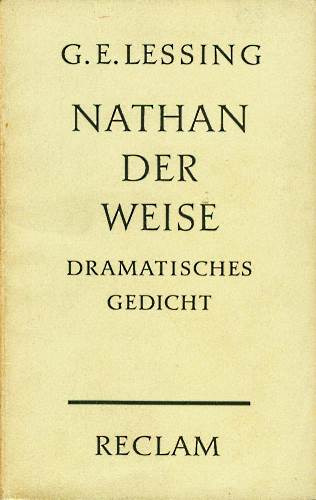
The Age of Reason saw the emergence of two literary movements: Empfindsamkeit (sentimental style) and Sturm und Drang (storm and stress). The first one intended to express true and natural feelings and featured sudden mood changes. The latter movement was characterized by individual subjectivity and extremes of emotion in response to the rationalism imposed by the Enlightenment.
Weimar Classicism (18th-19th centuries)
The main drivers behind Weimar Classicism, which synthesized ideas from Classicism, the Enlightenment, and Romanticism, were Johann Christoph Friedrich von Schiller, and Johann Wolfgang von Goethe.
During this period, Schiller published Die Bürgschaft (The Pledge), a ballad based on the legend of Damon and Pythias found in the Latin Fabulae, and Don Karlos (Don Carlos), a historical tragedy about Carlos, Prince of Asturias, while Goethe wrote Egmont, a play heavily influenced by Shakespearean tragedy, and Faust, a tragic play in which the main character sells his soul to the devil that is considered the greatest work of German literature.
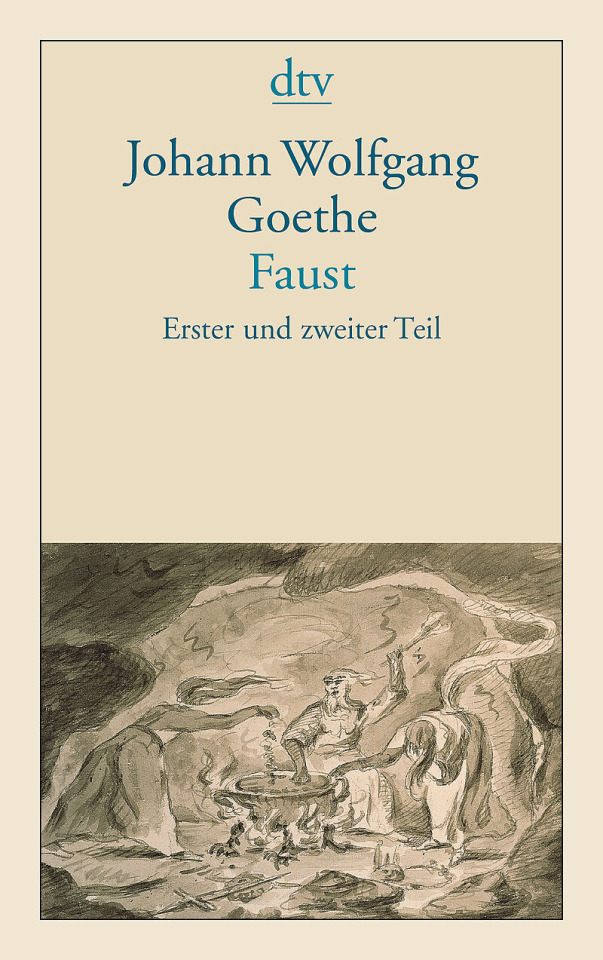
Romanticism (18th-19th centuries)
Important Romantic writers include E. T. A. Hoffmann, author of Der Sandmann (The Sandman), a short story based on the mythical character of said name that puts people to sleep by sprinkling sand on their eyes; Heinrich von Kleist, who wrote Das Kätchen von Heilbronn (The Little Catherine of Heilbronn), a drama set in Swabia in the Middle Ages; Joseph Freiherr von Eichendorff, author of Das Marmorbild (The Marble Statue), a novella about a man who struggles to choose between piety and a world of art, and Novalis, author of Hymnen an die Nacht (Hymns to the Night), a collection of six poems.

Folk tales collected by the Brothers Grimm became very popular during the Romantic period, as they represented a pure form of national literature and culture.
Biedermeier and Young Germany (19th century)
The Biedermeier period contrasts with the Romantic era and is best exemplified by poets Adelbert von Chamisso, Annette von Droste-Hülshoff, and Wilhelm Müller.
Young Germany was a youth movement whose main proponents were Karl Gutzkow, Ludolf Wienbarg, and Theodor Mundt.
Realism and Naturalism (19th century)
The most representatives realist authors are Gustav Freytag, Theodor Fontane, and Theodor Storm, while Gerhart Hauptmann was the most important naturalist writer.
Weimar literature (20th century)
During the Weimar Republic, writers such as Erich Maria Remarque, Heinrich Mann, and Thomas Mann presented a bleak look at the world and the failure of politics and society.

Expressionism (20th century)
As a modernist movement, Expressionism presented the world solely from a subjective perspective, distorting it for emotional effect. Famous authors include novelists Alfred Döblin and Franz Kafka, playwrights Ernst Toller and Georg Kaiser, and poets August Stramm and Else Lasker-Schüler.

Neue Sachlichkeit (20th century)
Neue Sachlichkeit (New Objectivity) arose as a reaction against expressionism and was characterized by its political perspective on reality and portrayal of dystopias in an emotionless reporting style, showing cynicism about humanity. Authors associated with this movement include Erich Kästner, Hans Fallada, and Irmgard Keun.
Nazi Germany (1933-1945)
During the Nazi regime, some authors went into exile, while others submitted to censorship. The former, who either were of Jewish ancestry or opposed the regime for political reasons, include writers Alice Rühle-Gerstel and Anna Seghers, playwright Bertolt Brecht, and poet and novelist Hermann Hesse/Emil Sinclair.
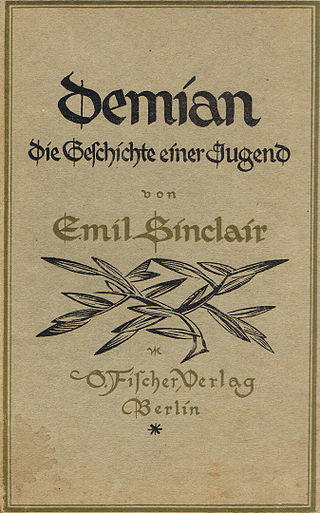
Those who stayed and engaged in inner emigration include writer Friedrich Reck-Malleczewen, poet and essayist Gottfried Benn, writer Hans Blüher, and poet and novelist Ricarda Huch.
Post-war literature (20th century)
The most famous authors in West Germany were Edgar Hilsenrath, Günter Grass, Heinrich Böll, and Group 47, a group of participants in writers’ meetings invited by Hans Werner Richter.
East German writers include Christa Wolf, Heiner Müller, Reiner Kunze, and Sarah Kirsch.
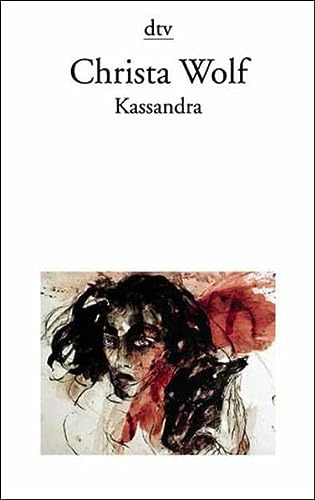
Contemporary literature (21st century)
Fantasy and science fiction authors include Andreas Eschbach, Frank Schätzing, and Wolfgang Hohlbein. Some of the most important poets are Aldona Gustas, Hans Magnus Enzensberger, and Jürgen Becker. Thriller is best represented by Ingrid Noll. Fiction novelists include Herta Müller, Siegfried Lenz, and Wilhelm Genazino.
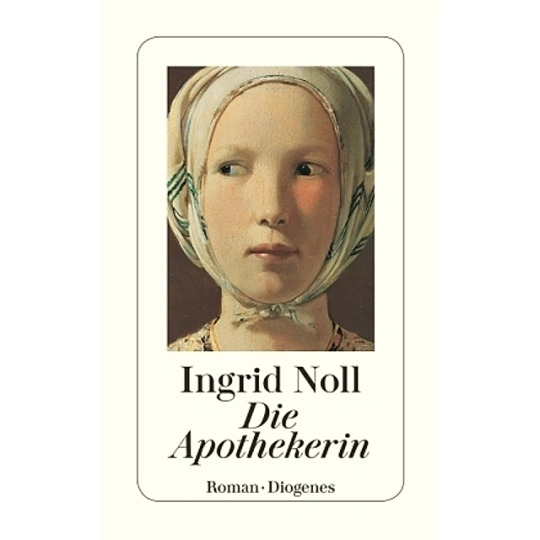
20 notes
·
View notes
Text
Erlking
In European folklore and myth, the Erlking is a sinister elf who lingers in the woods. He stalks children who stay in the woods for too long, and kills them by a single touch.

Pic by Sammycat17 on deviantart
The name "Erlking" is a name used in German Romanticism for the figure of a spirit or "king of the fairies". It is usually assumed that the name is a derivation from the ellekonge (older elverkonge, i.e. "Elf-king") in Danish folklore. The name is first used by Johann Gottfried Herder in his ballad "Erlkönigs Tochter" (1778), an adaptation of the Danish Hr. Oluf han rider (1739), and was taken up by Johann Wolfgang von Goethe in his poem "Erlkönig" (1782), which was set to music by Schubert, among others. Goethe added a new meaning, as "Erl" does not mean "elf", but "black alder" - the poem about the Erlenkönig is set in the area of an alder quarry in the Saale valley in Thuringia. In English translations of Goethe's poem, the name is sometimes rendered as Erl-king.
According to Jacob Grimm, the term originates with a Scandinavian (Danish) word, ellekonge "king of the elves", or for a female spirit elverkongens datter "the elven king's daughter", who is responsible for ensnaring human beings to satisfy her desire, jealousy or lust for revenge. The New Oxford American Dictionary follows this explanation, describing the Erlking as "a bearded giant or goblin who lures little children to the land of death", mistranslated by Herder as Erlkönig in the late 18th century from ellerkonge. The correct German word would have been Elbkönig or Elbenkönig, afterwards used under the modified form of Elfenkönig by Christoph Martin Wieland in his 1780 poem Oberon.
Alternative suggestions have also been made; in 1836, Halling suggested a connection with a Turkic and Mongolian god of death or psychopomp, known as Erlik Chan.
Johann Gottfried von Herder introduced this character into German literature in "Erlkönigs Tochter", a ballad published in his 1778 volume Stimmen der Völker in Liedern. It was based on the Danish folk ballad "Hr. Oluf han rider" "Sir Oluf he rides" published in the 1739 Danske Kæmpeviser. Herder undertook a free translation where he translated the Danish elvermø ("elf maid") as Erlkönigs Tochter; according to Danish legend old burial mounds are the residence of the elverkonge, dialectically elle(r)konge, the latter has later been misunderstood in Denmark by some antiquarians as "alder king", cf Danish elletræ "alder tree". It has generally been assumed that the mistranslation was the result of error, but it has also been suggested (Herder does actually also refer to elves in his translation) that he was imaginatively trying to identify the malevolent sprite of the original tale with a woodland old man (hence the alder king).
The story portrays Sir Oluf riding to his marriage but being entranced by the music of the elves. An elf maiden, in Herder's translation the Elverkonge's daughter, appears and invites him to dance with her. He refuses and spurns her offers of gifts and gold. Angered, she strikes him and sends him on his way, deathly pale. The following morning, on the day of his wedding, his bride finds him lying dead under his scarlet cloak.
Although inspired by Herder's ballad, Goethe departed significantly from both Herder's rendering of the Erlking and the Scandinavian original. The antagonist in Goethe's "Der Erlkönig" is the Erlking himself rather than his daughter. The Erlkönig appears to a young boy in a feverish delirium - his father, however, identifies the apparition as a simple streak of fog. Goethe's Erlking differs in other ways as well: his version preys on children, rather than adults of the opposite sex, and the Erlking's motives are never made clear. Goethe's Erlking is much more akin to the Germanic portrayal of elves and valkyries – a force of death rather than simply a magical spirit.
In Angela Carter's short story "The Erl-King", contained within the 1979 collection The Bloody Chamber, the female protagonist encounters a male forest spirit. Though she becomes aware of his malicious intentions, she is torn between her desire for him and her desire for freedom. In the end, she forms a plan to kill him in order to escape his power.
Charles Kinbote, the narrator of Vladimir Nabokov's 1962 novel, Pale Fire, alludes to "alderkings". One allusion is in his commentary to line 275 of fellow character John Shade's eponymous poem. In the case of this commentary, the word invokes homosexual ancestors of the last king of Zembla, Kinbote's ostensible homeland. The novel contains at least one other reference by Kinbote to alderkings.
In Jim Butcher's The Dresden Files, there is a character called the Erlking, modeled after the leader of the Wild Hunt, Herne the Hunter.
In the author John Connolly's short story collection Nocturnes (2004), there is a character known as the Erlking who attempts to abduct the protagonist.
The New Yorker's "20 Under 40" issue of July 5, 2010 included the short story "The Erlking" by Sarah Shun-lien Bynum.
A version of the Erl-King is mentioned in Zoe Gilbert's Mischief Acts, implied to be a figure related to Herne the Hunter.
In Andrzej Sapkowski's The Witcher saga, the highest leader of the Folk of the Alder elves, Auberon Muircetach, is also known as the Alder King. In the story, he maintains thematic ties to kidnapping: the Wild Hunt, known for abducting humans, is subordinate to him, and he orchestrates the imprisonment of Cirilla.
8 notes
·
View notes
Text
So, there's this scene in Cousin Bette, which has a pretty striking line:
– On a marché, dit le vieillard en se retirant, et les morts vont vite à Paris !
(Honoré de Balzac, La cousine Bette, 1846)
“The world moves on,” said the old man, as he withdrew, “and the dead move quickly in Paris!”
(tr. James Waring) (given the implications, I would translate the first half of Vautrin's reply as “We have made our move”)
and I was like, critique of capitalism, etc etc. My friend @madmerchant said she was pretty sure she'd read something very similar in Dracula. Was Stoker referencing Vautrin? Was it a coincidence? There's a persistent shroud of the Fantastic surrounding Vautrin, it would not be surprising if someone would have thought of him as a vampire, or an immortal creature of some kind... however:
“You are early to-night, my friend.” The man stammered in reply:—“The English Herr was in a hurry,” to which the stranger replied:—“That is why, I suppose, you wished him to go on to Bukovina. You cannot deceive me, my friend; I know too much, and my horses are swift.” As he spoke he smiled, and the lamplight fell on a hard-looking mouth, with very red lips and sharp-looking teeth, as white as ivory. One of my companions whispered to another the line from Burger’s “Lenore”:—
“Denn die Todten reiten schnell”—
(“For the dead travel fast.”)
oooh. this lead to discovering that Lenore, is one of the cornerstones of Romanticism. So it wasn't that Stoker was referencing Vautrin's last incarnation, but rather, the same originary poem Balzac hismelf was referencing. The influence of the poem was huge, and epsecially the french went crazy over it. The first translation was published in the Journal des Débats in 1811, translated from English. The newspaper published it, not without adding the poem put in display "the most odious vices of the German School".
It was not until Mme de Saël (she of the North vs South temperaments fame) wrote an article trully valuing the work as the poetic masterpiece it was, that the fever for Lenore started to root on the young minds of a Certain Group of Artists-and their readers- in 1820. Madame de Saël had thrown the gauntlet:
"No french translation, be it prose or verse, could express all the nuances and detaild of the German original."
and one Gérard de Nerval picked it up, offering FIVE translations of his own throuout the years...
The poem collects a German folk story, and as soon as you read the summery you *know* why the more edgy Romantics were crazy about it. Like other German folk tales (as Der Erlkönig) it features a frenzied ride through the forests, and a lover that is not what he seems to be (he is DEATH. The RIde is A TRAP) Embroildled in the poem are some anti nobility aspects:
"(in Lenore, we hear) The powrful and pained voice of a Titan, tormented until death by the aristocracy. (...) In German language, 'Bürger' (the poet's name) is synonimous to citoyen"
(Heinrich Heine)
and a desire to revindicate the autochthonous, popular poetry from the lower classes -the Lenore poem is recolected from a popular song Bürger heard a young peasant singing- as the true voice of a nation:
It will remain eternally true that if we have no Volk, we shall have no public, no nationality, no literature of our own which shall live and work in us. Unless our literature is founded on our Volk, we shall write eternally for closet sages and disgusting critics out of whose mouths and stomachs we shall get back what we have given.
(Johann Gottfried Herder)
So, what I'm saying is, I must read Lenore, and also, it is very likely that that Vautrin line is a direct reference to that icon of the dawn of French Romanticism, something the then elders (cousin bette was published in 1846) would have remembered and understood...
#french romantics#LENOREE!!#an incredibly influential poem ppl seem to overlook#thanks thoma for your brains/the talk XD#vautrin related#balzac related#nerval and stael#the origins of international romanticism#my source for the mme de stael quote and the nerval translations is an article on Lenore in Spain#by José Escobar#u can download it in the english wikipedia entry for lenore#lenore mania#French Romanticism Memes/catalogue of references they shuffled about#ofc nerval was a fan it’s his special interest-> german literature
5 notes
·
View notes